Manual on how to treat a cat
[Translated into English by Karin Sandbergen.]
| Below you'll find the text of "Handleiding voor de behandeling van de Kat" by L.J. Quarles van Ufford, printed in 1934. The original language of this booklet is Dutch. | 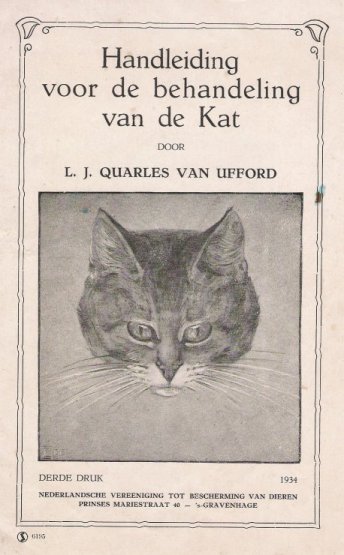 |
The Cat
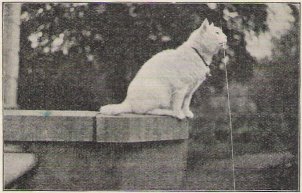 |
A slogan in a treatise about songbirds, caged birds and canary birds states: "One should empathise with their animals". With cats this is most certainly the case. Cats may be pets, but her wild nature has remained with her. No pet is therefore as wilful as the cat. One wants to take her to sit on their lap, she'll then jump off on the left, just to jump on from the right. To care well for an animal - a creature - one should learn about their physical well-being and especially their |
Character traits.
No two cats have the same character. A cat detests water on its skin. Yet, I heard about a cat that repeatedly swam across a ditch. I also knew of a cat that would sit on the bank of a stream for hours on end, fishing by striking out with her paw in the water. Once, she lost her balance and fell into the water. But she clambered out of the water very quickly, just to resume fishing.
It's sad that so many animals become a prey for cats. We judge the cat for continually going bird-hunting. But... we love it when she catches mice for us, which she treats in a very cruel way. What a contradiction!
Humans are like that, just like cats. And to learn about her true nature, one should empathise with their cat. One should observe and understand all about her quirks.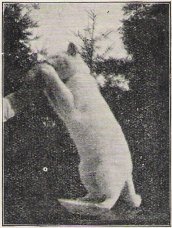 A cat is vicious! At least, that's what people say. I don't agree. On the other hand I venture to claim one can turn a cat, like all pets, into a gentle animal, just by the way they are brought up and handled.
A cat is vicious! At least, that's what people say. I don't agree. On the other hand I venture to claim one can turn a cat, like all pets, into a gentle animal, just by the way they are brought up and handled.
From the moment of birth one should inspire trust in her, handle her a lot, play with her and… talk to her, talk a lot and... talk softly.
That is why it makes such a difference, from which household the cat comes. One usually forgets one should categorise them under animals of prey. And no animal goes wild as quickly as a cat.
To tame a cat, to domesticate her and make her become attached to us, is a secret that's not known to everybody. One should love an animal and let it feel it's loved.
That a cat scratches us sometimes, is true. But this isn't viciousness, even though it seems that way! A cat uses its claws to hold on to things and to climb.
The cat's paw has 4 toes and a thumb and it's a peculiarity of the animal that she sometimes uses all 5 digits to hold on to something - just like monkeys and... we do.
When a cat holds on to us, we should take care extracting ourselves and never to withdraw our hand quickly.
We have a sweet cat that loves to climb onto our shoulders, especially when we're holding a little snack. But for the ladies it isn't pleasant when the cat's claws penetrate their shoulders, through the thin fabric of their clothes. However, is it then reasonable to speak of a vicious cat? ... Certainly not. When the cat grabs our hand to accept a nice titbit and we withdraw our hand, we wound ourselves on her claws, but we cannot declare the cat scratches us.
Enclosed photos show you our cat, taking a piece of liver, something she loves very much. Notice how she grabs the hand with her paws, but you can rest assured that she doesn't use her claws.
Whenever a cat strikes out with her claws, it's in self-defence, because she doesn't trust the situation.
Inspire trust in her and try to find out what she loves - for example in the area of her
Accommodation.
I've read somewhere, that a cat demands a pillow to sleep on, to curl itself gloriously up on it. This is somewhat exaggerated. For example, a cat loves to lie on paper, thin or thick. Take note: whenever the newspaper is on the table, pussycat will lie on it.
In the room where she slept, we had a so-called cat basket for our cat, but she never made use of it, or very rarely. It was a junk room with tall and low cupboards and on one of those cupboards, a cupboard hanging on the wall, she had her sleeping-place. How she reached that in the dark, has always remained a mystery to us. Even in broad daylight it was quite a feat. But on that cupboard stood a tool box and another box, about 30 centimetres long, 15 centimetres wide and 10 centimetres deep. That was her favourite bed. And sometimes she slept on top of the tools!
One night, the large dog had to spend the night in the room and the dog basket was placed there. Out of curiosity, because cats are highly inquisitive, pussycat was sitting in the middle of it very quickly.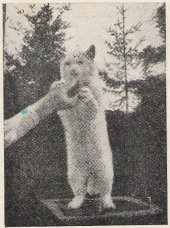 After we'd moved house, she got another room, of course, which had a different, large basket lying on its side. And, lo and behold, wasn't that delightful! Just as in later days, the junk cupboard - she always used to climb in, whenever the door was ajar.
After we'd moved house, she got another room, of course, which had a different, large basket lying on its side. And, lo and behold, wasn't that delightful! Just as in later days, the junk cupboard - she always used to climb in, whenever the door was ajar.
The morale of this all: try to find out which place the cat prefers most!
It's certain, that as a rule she prefers a very high sleeping-place. In the animal shelter in The Hague, in all the cages, there are little wooden boxes against the ceiling and they're favourite with all the cats. The animals can sit there peacefully. At the first renovation of the shelter, the department where the cats were kept was above that of the boarding dogs, under the roof. And it was already clear that the cats were always sitting on the beam, if it ran through their cage. That's why in every new cat accommodation, boxes were placed against the ceiling.
It's been a long time since in the old shelter an accommodation for cats was made. Information was acquired from England beforehand and the board of directors was informed of the fact that keeping a lot of cats together in one room was strongly frowned upon, as this was a cause of unhappiness in some animals, because of intimidation between cats. Also, contagious diseases and even deaths could be the consequence. This was the reason that in the The Hague animal shelter every cat had its own space. And with excellent result! One such space has a measure of one metre wide, 1½ metres deep and over 2 metres high. At 0.75 metre high there's a plank or table across the whole width, with a depth of about 80 centimetres. It has a sloping, ridged plank leaning against it, along which the animals can clamber up. The table has in one of its corners another, free-standing little table, under which a basket can be placed. During hot weather the cats got, instead of the basket, a sheet of paper, which they loved, but the shelter had to discontinue, because of scarcity of paper. On the ground stands the stone or enamelled box (cat's box), which is cleaned daily. Every day those boxes have to be cleaned, or else the cats become not house-trained. The box should contain dry (white) sand, sawdust or peat litter (not peat dust).
On the shelf one should place bowls with
Food and drink.
What should a cat eat? Anything that is on the menu. There are of course things they don't like, and what one cat loves, the other cat won't touch. That's how it works for us and that's how it also works for animals. But I'm willing to declare that all cats love oatmeal porridge. Our cat, for example, never likes to snack, but she can't resist porridge.
When feeding a cat, in the first place one should take notice of the condition of the cat. If she's young, if she's about to have kittens or just had them, if the tomcat is out on the roofs a lot and comes home with holes in his cheeks and covered in scratches, if it's summer or winter and also if she has recently been ill and needs building up a little. It is said that one should feed kittens raw meat, as soon as they want to take it. Although a little meat every now and again, isn't harmful, a diet that consists largely of meat will be very detrimental. Good, uncooked, tepid milk, porridge cooked with milk and, when the kitten is older, some cooked vegetables, lentils and peas in their own cooking water with broth is so much better, because it is more easily digestible.
After the cat has cut its permanent teeth, one may give them some lightly digestible meat. Good cat bread, cooked or softened with broth, is also excellent and although variety in food is necessary, it is recommended when acquiring a cat, to ask how she should be fed, because a sudden change in diet can be adverse.
It is impossible to give a universal instruction on how to feed a cat, because this is almost never the same for any two cats. A cat should finish a meal with taste and one shouldn't leave her food just "standing there". On the other hand one should never spoil their cat for simple food, by always feeding them fine food, like fried bones.
It is advisable to not always give softened and soft food. This is not good for the teeth, or for the intestines, because the stomach can't do its work properly and the gastric function is disturbed. The beneficial effect that saliva has on the digestion, will be eliminated.
Healthy cats like to munch on dry cakes, dried fish and meat.
That a cat needs two square meals a day is again not an axiom. However, one should always keep the following in mind: regularity, great hygiene in everything, variety in diet, enough but never too much and always clear water in abundance.
When the weather is cold one should try to raise the inner heat by giving more powerful food. Birds are given poppy seed. For cats, more meat and fish in somewhat larger quantities is very suitable. We've read in an English magazine, that one should give a cat more meat and fish, when she gets older. And, of course, it emerges that this also applies to cats that need building up and strengthening a little.
It occurs that cats, like dogs, don't like milk. In that case, give them some goat's milk, even watered down a little. They'll love it, of that we're convinced.
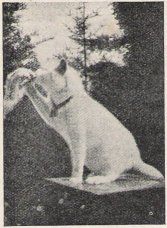 In an English book we read that one should give cats uncooked milk. It doesn't explain why. Isn't it possible that they, like many among us, don't appreciate the unnatural "cooking taste"? An expert, with whom we spoke about it, didn't want to assert that cats aren't susceptible to typhoid, foot-and-mouth disease or tuberculosis, which is why we cook the milk. But he declared that uncooked milk is more nutritious. In our opinion, one could give goat's milk, because of the special way we keep goats - contrary to other cattle - properly, without cooking it, and that therein lies the secret.
In an English book we read that one should give cats uncooked milk. It doesn't explain why. Isn't it possible that they, like many among us, don't appreciate the unnatural "cooking taste"? An expert, with whom we spoke about it, didn't want to assert that cats aren't susceptible to typhoid, foot-and-mouth disease or tuberculosis, which is why we cook the milk. But he declared that uncooked milk is more nutritious. In our opinion, one could give goat's milk, because of the special way we keep goats - contrary to other cattle - properly, without cooking it, and that therein lies the secret.
Bread, preferably stale, is also a main diet staple and is given soaked in milk. For cats that don't want to eat it, one mixes it with solid food.
In England exhibitions are the order of the day and they have so much success, that one keeps animals only for that purpose. Without wanting to come across as a champion of the exhibiting of animals, I cannot help but think that the English exhibitions have a wholesome effect on the care of the animals, because the condition the animals should be in at the show, are subject to criticism of a jury. People go as far as to feed their pets only animal food and, as variety in diet is advisable, give them meat one day and the other day, fish.
For cats that are "off their food" one recommends ox liver, cooked and then hard-fried and grated over the food. This will soon have them eating again. Now, there are small eaters under cats, that haven't therefore gone off their food, while one also mistakes greediness for hunger.
It's very curious how we're always looking for strengthening food and throw away the best of the food. Thus, we usually throw away the water the vegetables are cooked in, while it's rich in nutrients. We use it, instead of water, to moisten the food of dog and cat. So it seems that limewater is very beneficial, especially for young cats. It suffices us by giving a teaspoon full of phosphoric acid (bone meal) that in small quantities is so advantageous for the bones. Bigger quantities give cause for constipation.
English breeders allege that no nutrient has so much healing power as grass. They go as far as to sow grass in pots and subsequently place them in reach of their cats, whenever there isn't a lawn in the vicinity to let their cats loose on.
It can also be a need to bite into something, to use the teeth, as well as a need for certain ingredients and stimulants (nutrients).
Illnesses, injuries, etc.
Next, from the nature of things we'll only mention so-called home remedies and it can therefore merely serve as first aid in case of accidents. Illnesses and injuries of a serious nature, should be treated by veterinarians.
The prescribed treatment by a veterinarian isn't to be carried out easily by a layman. For example giving food, liquid or solid. If it's difficult to treat a cat, in the first place one should take care that the animal can't offer any resistance and will scratch. To that purpose, one wraps a large cloth around the body and with it, the paws. To pour down a medicine one shouldn't break open the mouth, but leave it closed. One simply sticks an index finger in the mouth of the animal, between the cheeks and molars and in that way form a little pocket, wherein one pours down the medicine in small amounts. The easiest way is to make use of a pharmacy bottle of approximately 20 grams, wherein one has put the specific amount. For pouring down castor oil one takes a bigger bottle, otherwise one can't pour down enough. By putting it in a cup of warm water, one can make the castor oil in the bottle more liquid and thinner. By putting the bottle against one's (closed) eye or against the cheek, one can judge if it's not too warm. When pussycat doesn't want to swallow, one should pinch her nose for a moment. The head should be kept upright during this process.
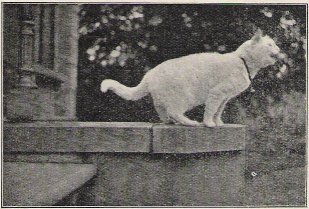 Pills should be placed on the back of the tongue, as deeply as possible. Powders should, for all intents and purposes, be placed in the same place. Powders are given more easily, because the powder will soon adhere to the mucosa and nothing is lost, except that, which is coughed away. Powders can also be given in stiffly beaten egg whites.
Pills should be placed on the back of the tongue, as deeply as possible. Powders should, for all intents and purposes, be placed in the same place. Powders are given more easily, because the powder will soon adhere to the mucosa and nothing is lost, except that, which is coughed away. Powders can also be given in stiffly beaten egg whites.
Subsequently, we only want to discuss the cases that can easily be treated by laymen, for example:
Mild ear infection
One notices very swiftly whether a cat suffers from that, for example, because it scratches itself with its hind leg. It can be cause for injury, but the ailment itself is the result of inflammation of the skin of the auditory duct, which discharges a very unpleasantly smelling fluid and is the cause for contamination. One regards the poor animal. It lowers the diseased ear and it shakes its head continuously.
When one empathises with their animals, one notices immediately what's going on and then treatment is simple. One turns a piece of surgical cotton wool around the end of a matchstick, from which the sharp edges have been removed and cleans the ear with that, there where it's giving trouble and one also cleans all the folds of the ear. One can go quite deeply, but one should be very careful not to touch the eardrum! If the cotton wool - one prepares about four or five beforehand - doesn't get dirty anymore, then, in the same way, one puts a piece of cotton wool with boracic ointment into the ear. Within a few times the complaint should be remedied.
The piece of wood shouldn't injure the ear.
When the infection is more significant, one should call in the help of a veterinarian.
It could also be caused by warts and what one calls, cancer of the ear. In this case the veterinarian should also interfere.
To see deeply into the auditory duct, one should pull the auricle a little.
Digestive defects
It isn't advisable to give purgatives. When it's a case of constipation, one does best to give some cooked vegetables or some salad oil. The oil from sardines is also very good and when one mixes it with some drops of castor oil, this will be lapped up eagerly.
Nor is it advisable to combat thin faeces with certain astringents. A chance in diet, for example with some rice, is then to be recommended. Does the ailment become more serious, one should seek help from a veterinarian.
Fits or seizures
It happens that a cat seems very healthy, then suddenly collapses and becomes convulsed, to slowly and dazedly regain consciousness after a few moments, while liquid and mucus come from the mouth. Such attacks can have many different causes. One shouldn't neglect to consult a veterinarian.
Awkward visitors
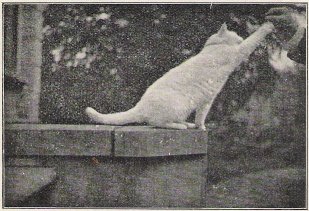 Earlier, we discussed greediness. This greediness can be caused by worms and in that case the animal can eat as much as it likes and still stay skinny. Does it therefore attract your attention that your animal displays an extraordinary appetite, convince yourself that there are fragments of worms in her box, smaller or bigger white sections, which point to her having worms. In that case a veterinarian should prescribe a remedy for your cat.Tapeworms secrete elongated sections of 1 centimetre long and 3 millimetres wide.
Earlier, we discussed greediness. This greediness can be caused by worms and in that case the animal can eat as much as it likes and still stay skinny. Does it therefore attract your attention that your animal displays an extraordinary appetite, convince yourself that there are fragments of worms in her box, smaller or bigger white sections, which point to her having worms. In that case a veterinarian should prescribe a remedy for your cat.Tapeworms secrete elongated sections of 1 centimetre long and 3 millimetres wide.
It won't be necessary to mention that the flea too, is an unpleasant and awkward animal. Certainly for cats and not in the least for the long-haired ones, because her fur is very woolly and dense.
One combs the animals and washes them with the more harmless detergents that are available. One can get information about it from any veterinarian, pet clinic or animal shelter.
The basket and sleeping-place of the cat should also be cleaned thoroughly, because these can - and will - be contaminated by eggs and larvae.
The cat louse is a grey and yellow insect with an oval body, approximately the size of a pin-head. It can usually be found there, were the cat can't reach with their paws and on the bodies of unkempt and weakened animals. The parasite causes a sort of dandruff, by which it can be recognised, but first one discovers numerous nits or eggs, that are placed obliquely on the hairs.
To cure the cat of this, with good result, one should, at the same time when one is fighting the lice, let the cat recuperate. Since the skin of these cats is especially dry, one should give them as much fat as possible.
There are detergents available, which are not poisonous, but one should remember, that carbolic acid, lysol, creolin and other such remedies will be absorbed into their skin and can be lethal. The so-called cologne for the hair is also wrong.
 Mange
Mange
This is an illness of a much serious nature and also much harder to cure. The parasite that causes her, belongs to the mites (Acarids) and looks like the cheesemite. She's so very small, that she can't be seen with the bare eye. But, as small as she is, she's incredibly fertile. She digs herself into the skin and lays about 24 eggs there. These hatch within the space of a week and after a few weeks these young also lay eggs. And thus, reproduction goes so fast, that there are 1,000,000 offspring within 90 days!
A cat gets mange by coming into contact with cats that are already infected. The illness can pass on to dogs and even people. Luckily, not every skin disorder is mange. Don't get inordinately afraid, but be careful and consult the veterinarian as soon as you notice bald spots on the skin, around the eyes, on the ears etc. of your cat.
Wounds
During treatment of wounds great hygiene is a prerequisite and one should keep the wounds as clean as possible. However, many disinfectants are poisonous for cats, so that one should be very careful. A good remedy is potassium permanganate 1 : 300. Also, hydrogen superoxide H2O2 and 2% sodium carbonate solution. It's better to prevent than to cure. Of course, one can't prevent a cat getting bitten or cutting itself by falling through a window, for example. What one can prevent is that pussycat plays with the pins and needles on the pincushion. Cats seem to love those ladies' articles very much and they also seem to taste very well. Repeatedly, cats have to be treated because a needle or pin is lodged in their throat. I even know about a case, where a cat had swallowed a 17 centimetres long hatpin, with the head downwards.
Needless to say, that even in such cases the help of a veterinarian should be sought, since it certainly requires the cat to be brought under an anaesthetic.
But one should also take care that pussycat doesn't get hold of large bones of birds, because the fragments of these bones are so sharp, that they usually become lodged in the intestines and the animal needs to have an operation. That is, if one discovers what's ailing pussycat!
Operated on - under anaesthetic. Because an
Anaesthetic
Is always to be preferred, since the physician can then perform in a more peaceful way, therefore won't wound the animal unnecessarily and, which is of great importance, won't torture the animal by the enormous fear it would experience during the operation. The wound of an animal, that's operated on under anaesthetic, heals much better and more rapidly, because the animal, at least the first days, the days so much depend upon, won't be aware of what has happened. An animal, that's operated on while fully conscious, will quickly start trying to tear off its bandages.
Burns
These, one treats as quickly as possible with lots of boracic ointment or vaseline and even butter is excellent for the first treatment.
Listlessness
Sick cats, cats that are apathetic, that have no appetite, without us knowing what is wrong with them. In Japan one is in the habit of giving a raw egg and one claims that they've subsequently recovered.
It should be put to the test, once.
Prior to ending this essay, we would like to warn against the results of the great curiosity of these animals.
It seems that a cat has the need to go exploring everywhere and therefore crawls into every hole, which she can barely fit into. For example, how often does one hear about cats that have become stuck under floorboards or bricked in behind walls or locked up in cupboards and thereby got lost? Recently, I heard about a black cat, which crawled into a stove, after which it was closed and the stove lit.
It was only by great coincidence that the cat was saved just in time.
Tomcats, which aren't neutered, are as a rule - during certain times - not house-trained. At the age of six months (or older) the neutering can be performed by the veterinarian under anaesthetic, completely free of pain and safe.
This is to be recommended.
The killing
After all is said and done, there's still this: To give a cat or dog, that's critically injured or incurably ill, a peaceful death, one does best to consult a veterinarian, who'll decide, in every separate case, which is the best way to release the animal out of its misery.
